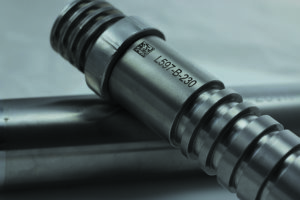What do DVD players, checkout lines at the grocery store, and industrial marking machines all have in common? Lasers.But not all lasers are the same.
L.A.S.E.R. stands for Light Amplification by Stimulated Emission of Radiation. In simpler terms, it’s a highly concentrated beam of light. Lasers consist of a:
- Gain medium: a material that works in tandem with electrical currents to stimulate the photons of light as it passes through
- Energy supply: Energy supply for lasers usually comes in the form of electrical currents. These currents are “pumped” through the grain medium to stimulate the atom as light passes through. The pumping of electrical currents causes the light to bounce faster through the grain medium.
- A material to provide optical feedback: The materials chosen for optical feedback have one primary job: steering. the way the beam of light is directed
While the standard laser pointer used in conference rooms and lecture halls are safe for the user with no protection, part marking lasers fall into two classes governed by the CDRH – Class I and Class IV:
- Class I lasers are housed inside a safety enclosure. No laser radiation can escape from the enclosure, and the machine operator doesn’t need to take any additional safety precautions.
- Class IV means the laser is applied in an “open” configuration where the operator can be directly exposed to laser radiation. In this case, laser safety glasses are a must.
Both classes of lasers are used in industrial laser marking systems, and are able to produce different types of results depending on the material being marked. Some jobs may require a mark that requires no physical damage be done to the substrate while others require deep engraving.
Here are 5 applications laser marking systems have in the manufacturing industry:
5 Applications for Laser Marking Systems:
Different projects and materials call for different applications. With ever-improving technology, laser marking systems can perform:
- General marking
- Annealing
- Ablating
- Deep engraving
- Plastic marking
1. General Marking
General marking can be more or less aggressive depending on the desired color of the mark.
This type of marking can be executed on most metals, including steel and aluminum. Best of all, it’s easy to program and extremely durable.
2. Annealing
Annealing can be used when no visible surface disruption is desired.
The material is heated by the laser beam to create a dark or burned mark that’s smooth to the touch. This method is commonly used on medical part marking, such as surgical tools or implants, so no physical disruptions occur.
Common materials that are annealed include:
- Stainless and non-stainless steel
- Chrome
- Cobalt
- Titanium
- Elastomer
3. Ablating
Ablating is the process of removing some of the surface coating in order to mark or reveal the underlying material.
This is common practice in anodized aluminum products, painted materials, or heat-treated surfaces. Ablating creates different levels of contrast between the mark and unaffected areas.
4. Deep Engraving
Typically employing a high-powered fiber laser, this type of marking involves removing material. The depth of the mark is a function of:
- Power
- Speed
- Frequency (how many pulses (kHz) per second)
Manipulating these variables allows you to control the depth of the mark.
This process can be used on a variety of materials, including rubber and metal.
5. Plastic Marking
Since plastic has a lower melting point than metal, certain laser settings will need to be adjusted. Lower power and higher speed is needed when marking when on plastic. This creates a more controlled “micro-burn” on the surface of the plastic.
Many manufacturers who are marking on a variety of substrates opt to purchase fiber laser technology (a near IR operating laser) due to the versatility allowed to mark a wide range of materials for many part marking applications. This is the most commonly used laser in marking for manufacturing.
All Technomark lasers use fiber technology, which offers the broadest application reach for marking ferrous and non-ferrous metals, many plastics, as well as rubber and elastomers.
Market Drivers and Industry Adoption of Laser Marking Systems:
From the medical industry to electronics, part marking plays a large role in maintaining quality control standards, brand recognition, and chain of custody.
Laser marking systems have use in several industries, including:

- Medical
- Tooling
- Automotive
- Aerospace and defense
- Electronics
- Oil and gas
- Home goods
- Industrial-grade machinery
- General industry
Most industries have adopted laser marking systems as a track-and-trace solution for whatever part they’re producing. By marking a 2D barcode, like Datamatrix, on the part, these marks are scannable throughout the assembly process for full visibility of work in progress on the factory floor. This includes tracking:
- Configuration management – Tracking which parts are used in which assemblies.
- Production bottlenecks – How long parts take to move through the assembly process, and where they might be losing efficiency.
- LEAN analysis -The number of assembly steps required to create the finished product.
This is specifically important for government/military and aerospace applications where stringent standards regulate each component of a system.
Some companies have also used part marking as a means to increase brand awareness and discourage counterfeiting. Having a logo, DataMatrix, or other unique marks that are difficult to replicate can ensure that no black market products enter your supply chain. This potentially prevents costly recalls.
Laser Marking Systems Applications:
Laser marking systems are ideal track-and-trace solutions. These techniques are used in the production of stainless steel medical equipment, electronic components, vehicle manufacturing, and more.
Part-marking solutions allow you to track and trace each part produced. Scannable parts add traceability to each station and worker that touches a part. Marking parts with a specific logo, DataMatrix, VIN, or other identifying mark reduces the risk of fake or shady knockoffs.
Source: Technomark




